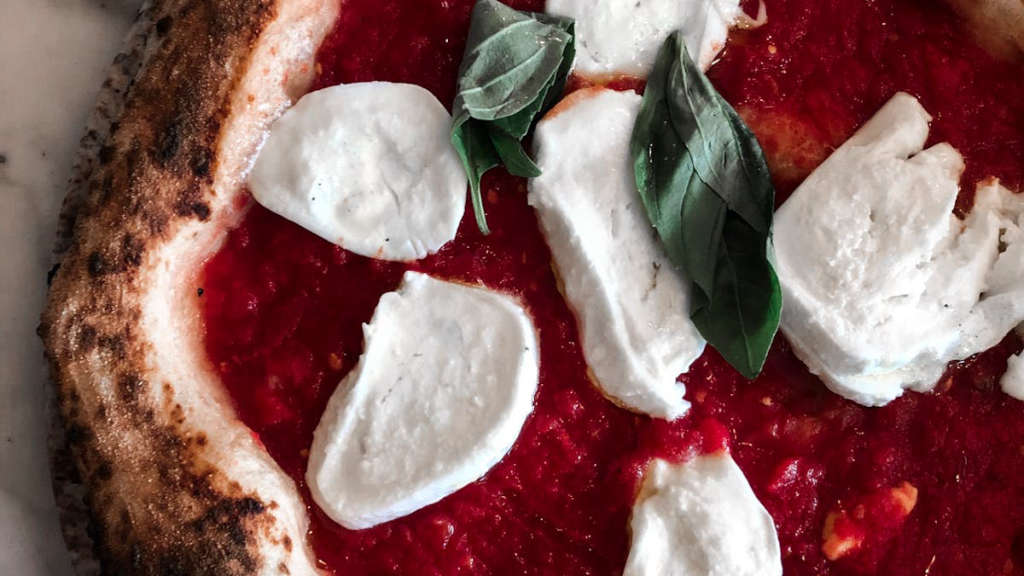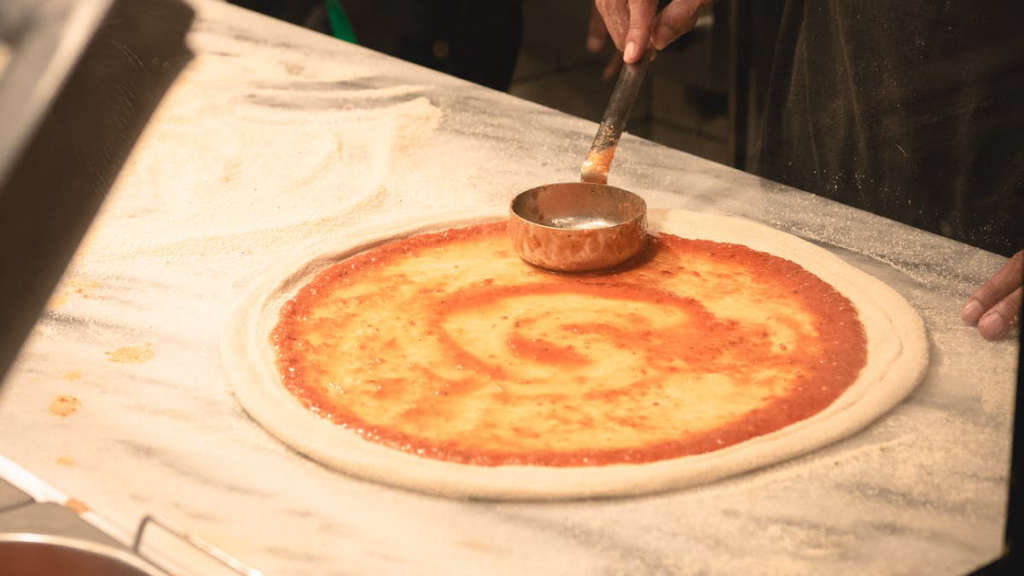Are you tired of store-bought pizza sauce and looking for a delicious and quick homemade alternative? Look no further! This easy homemade pizza sauce recipe is perfect for all pizza lovers. Not only is it simple to make, but it also adds a fresh and authentic flavor to your homemade pizzas. Whether you’re hosting a pizza night with friends or whipping up a quick weeknight dinner, this homemade pizza sauce is sure to impress. Let’s dive into the recipe and start making some mouth-watering pizzas!
Delicious and Quick Homemade Pizza Sauce Recipe Main Points:
- Simple ingredients: Gather all the ingredients you need for the homemade pizza sauce.
- Quick and easy preparation: Follow the step-by-step instructions for making the pizza sauce.
- Delicious and versatile: Learn how to use the homemade pizza sauce in various pizza recipes.

The History of Pizza Sauce and Its Evolution
Pizza sauce is a key ingredient that gives pizza its signature flavor. It has a long and interesting history that has evolved over time. Let’s take a closer look at the journey of pizza sauce and how it has changed over the years.
Early Beginnings
1. In the early days of pizza making in Italy, pizza sauce was a simple combination of crushed tomatoes, olive oil, and a few basic herbs and spices.
2. The sauce was spread thinly over the dough to add flavor and moisture to the pizza.
Introduction of New Ingredients
3. As pizza gained popularity and spread to other parts of the world, new ingredients were introduced to the sauce to suit different tastes and preferences.
4. Garlic, onions, and various types of cheeses were added to the sauce to enhance its flavor and create different variations of pizza.
Industrialization and Commercialization
5. With the industrialization of food production, canned and bottled pizza sauces became readily available, making it easier for pizzerias and home cooks to access pre-made sauces.
6. Companies started experimenting with different flavors and textures, offering consumers a wide range of pizza sauce options.
Modern Trends
7. In recent years, there has been a resurgence of traditional and artisanal pizza sauce made from fresh, locally sourced ingredients.
8. Chefs and pizza makers are focusing on creating high-quality, flavorful sauces using organic tomatoes, unique herbs, and specialty spices.
9. There is also a growing trend of fusion pizza sauces, incorporating global flavors and ingredients to create innovative and unique pizza creations.
As we can see, the history of pizza sauce is a story of evolution, adaptation, and creativity. From its humble beginnings to the modern gourmet creations, pizza sauce continues to play a vital role in the world of pizza-making.

Key Ingredients for a Perfect Homemade Pizza Sauce
Making homemade pizza sauce is a great way to elevate your pizza game. While store-bought sauces are convenient, nothing beats the flavor and freshness of a homemade sauce. To achieve the perfect homemade pizza sauce, it’s important to use the right ingredients. Here are the key ingredients you’ll need:
1. San Marzano Tomatoes
San Marzano tomatoes are the gold standard for pizza sauce. These Italian plum tomatoes are known for their sweet flavor, low acidity, and thick flesh. When making pizza sauce, reach for a can of San Marzano tomatoes for the best results. Use a hand blender or food processor to puree the whole tomatoes until smooth.
2. Fresh Basil
Fresh basil is a must-have ingredient for a flavorful pizza sauce. The bright, aromatic flavor of basil adds a delicious freshness to the sauce. Chop the basil finely and add it to the tomato puree for a burst of herbal flavor.
3. Garlic and Onions
Garlic and onions are essential for adding depth and complexity to your pizza sauce. Sauté finely chopped onions and minced garlic in olive oil until they’re soft and translucent. Then, add the tomato puree and let the flavors meld together as the sauce simmers.
| Ingredient | Amount |
|---|---|
| San Marzano Tomatoes | 1 can (28 ounces) |
| Fresh Basil | 1/2 cup, chopped |
| Garlic | 3 cloves, minced |
| Onion | 1/2, finely chopped |
By using these key ingredients in your homemade pizza sauce, you’ll be on your way to creating a delicious, flavorful sauce that will take your homemade pizzas to the next level. Experiment with the ratios and seasonings until you find the perfect blend of flavors that suits your taste.

Exploring Different Variations of Homemade Pizza Sauce
When it comes to making homemade pizza, one of the key elements that sets it apart from store-bought pizza is the sauce. While there are many different variations of pizza sauce that you can buy at the store, making your own at home allows you to customize the flavor and ingredients to suit your preferences.
One of the most important things to consider when making homemade pizza sauce is the base. Traditional pizza sauce is made from tomatoes, but there are many different ways to prepare the base. Some people prefer to use fresh tomatoes, while others opt for canned tomatoes for a richer flavor. Additionally, you can also experiment with different types of tomatoes, such as cherry tomatoes or San Marzano tomatoes, to add complexity to your sauce.
Another crucial component of homemade pizza sauce is the seasoning. While traditional pizza sauce typically includes garlic, oregano, and basil, there are endless possibilities for adding depth and flavor to your sauce. You can experiment with herbs like thyme, rosemary, or even red pepper flakes for a spicy kick. Don’t be afraid to get creative and try out different combinations to find the perfect flavor profile for your homemade pizza.
Experimenting with Different Ingredients
One of the essential elements of making homemade pizza sauce is the flexibility to experiment with different ingredients. For example, if you’re looking for a sweeter sauce, you can add a touch of honey or balsamic vinegar to enhance the natural sweetness of the tomatoes. On the other hand, if you prefer a tangy sauce, you can include a splash of red wine or a squeeze of lemon juice.
Overall, making homemade pizza sauce allows you to explore endless variations and combinations to create a sauce that is truly unique to your taste. Whether you prefer a classic tomato-based sauce or want to experiment with different flavors and ingredients, the possibilities are endless when it comes to homemade pizza sauce.
The Art of Simmering and Seasoning Pizza Sauce to Perfection
Being able to perfect the art of simmering and seasoning pizza sauce can truly elevate the taste of your homemade pizzas. The right combination of ingredients and the perfect cooking technique can make all the difference in creating a delicious, flavorful pizza sauce.
Simmering the Sauce
Simmering the pizza sauce is a crucial step in developing its depth of flavor. It allows the flavors of the ingredients to meld together and intensify. To achieve the perfect simmer, start by bringing the sauce to a gentle boil and then reducing the heat to low. Let the sauce simmer for at least 30 minutes, stirring occasionally to prevent it from sticking to the bottom of the pan.
Seasoning the Sauce
Seasoning the pizza sauce is where you can really unleash your creativity. Start with the basics, such as salt, pepper, and garlic powder. Then, consider adding a kick of heat with some red pepper flakes or a touch of sweetness with a pinch of sugar. Experiment with different herbs and spices, such as oregano, basil, and thyme, to find the perfect balance of flavors.
Perfecting the Balance
When it comes to simmering and seasoning pizza sauce, the key is to find the perfect balance of flavors. Pay attention to the taste as you season the sauce, making adjustments as needed. Remember, you can always add more seasoning, but you can’t take it away, so start with a light hand and taste as you go.
The Result
When you’ve mastered the art of simmering and seasoning pizza sauce to perfection, the result is a sauce that is rich, bold, and bursting with flavor. It will add depth and complexity to your homemade pizzas, making them truly irresistible.
Tips for Choosing the Right Tomatoes for Your Pizza Sauce
When it comes to making the perfect pizza sauce, the type of tomatoes you use can make a huge difference. The right tomatoes can add depth of flavor, richness, and sweetness to your sauce. Here are some tips for choosing the right tomatoes for your pizza sauce:
1. Look for San Marzano Tomatoes
When it comes to making authentic Italian pizza sauce, San Marzano tomatoes are often the go-to choice. These tomatoes are known for their bright red color, firm texture, and rich flavor. They are less acidic and have fewer seeds, making them perfect for creating a smooth and velvety sauce. Look for San Marzano tomatoes that are certified DOP (Denominazione di Origine Protetta) to ensure their authenticity.
2. Consider Using Roma Tomatoes
Roma tomatoes, also known as plum tomatoes, are another excellent choice for pizza sauce. They have a meaty texture and low moisture content, which means they produce a thick, flavorful sauce without being too watery. Roma tomatoes are also less acidic than other varieties, adding a hint of sweetness to your sauce.
3. Experiment with Heirloom Tomatoes
If you’re feeling adventurous, consider experimenting with heirloom tomatoes for your pizza sauce. These tomatoes come in a variety of colors, shapes, and sizes, each offering a unique flavor profile. From the sweet and tangy Brandywine to the rich and smoky Black Krim, heirloom tomatoes can add complexity and character to your sauce.
When choosing tomatoes for your pizza sauce, it’s important to consider their flavor, texture, and acidity. By using the right tomatoes, you can elevate the taste of your pizza and create a sauce that is truly authentic, flavorful, and delicious.
The Versatility of Homemade Pizza Sauce in Other Recipes
Homemade pizza sauce is not just for pizzas! Its rich, savory flavor can elevate a wide variety of dishes, making it a versatile and indispensable ingredient in any kitchen.
One of the great things about homemade pizza sauce is that it can be easily customized to suit your taste preferences. Whether you like it spicy, garlicky, or herb-infused, you can tailor the sauce to enhance the flavors of different dishes.
Uses of Homemade Pizza Sauce in Other Recipes
| Dish | Use of Pizza Sauce |
|---|---|
| Pasta | As a flavorful base for pasta sauces |
| Sandwiches | As a spread for sandwiches or wraps |
| Meatballs | As a topping for meatball subs or as a glaze for meatballs |
| Roasted Vegetables | As a flavorful coating for roasted vegetables |
Bobby Flay once said, “The secret to a great pizza is the sauce“
Next time you make a batch of homemade pizza sauce, consider making a little extra to use in other dishes throughout the week. You’ll be amazed at how a dollop of pizza sauce can transform a simple meal into something truly extraordinary.
Enhancing Flavor with Fresh Herbs in Pizza Sauce
When it comes to making delicious pizza, the sauce is a critical component that can either make or break the entire dish. While many people rely on store-bought pizza sauce, adding fresh herbs can take your pizza to the next level. Here’s how you can enhance the flavor of your pizza sauce using fresh herbs:
1. Choose the Right Herbs
When selecting herbs for your pizza sauce, opt for fresh, aromatic herbs that complement the other flavors in the dish. Some popular choices include basil, oregano, thyme, and rosemary.
2. Use Them Sparingly
While fresh herbs can elevate the flavor of your pizza sauce, it’s important to exercise restraint when adding them. Too many herbs can overpower the sauce and detract from the overall taste of the pizza.
3. Add Them at the Right Time
To maximize the flavor of the herbs, add them to your pizza sauce at the end of the cooking process. This will preserve their freshness and prevent them from becoming bitter.
By incorporating fresh herbs into your pizza sauce, you can create a rich and flavorful base for your favorite toppings. Experiment with different herb combinations to find the perfect flavor profile for your homemade pizza.
The Science Behind Achieving the Ideal Pizza Sauce Consistency
When it comes to making the perfect pizza, the sauce is a crucial element that can make or break the entire dish. The ideal pizza sauce should have a balance of flavor, consistency, and texture to complement the other ingredients and create a delicious final product.
So, what is the science behind achieving the ideal pizza sauce consistency? Let’s take a closer look.
Ingredients
The first step in achieving the ideal pizza sauce consistency is selecting the right ingredients. The sauce typically contains tomatoes, garlic, herbs, and spices. The type of tomatoes used, whether fresh or canned, will greatly impact the consistency of the sauce. Fresh tomatoes will produce a thinner sauce, while canned tomatoes will result in a thicker sauce.
Cooking Method
The cooking method also plays a significant role in determining the consistency of the pizza sauce. Simmering the sauce for a longer period will help to reduce the moisture content and thicken the sauce. On the other hand, if a thinner consistency is desired, the sauce can be cooked for a shorter amount of time or even used raw.
Texture Enhancement
To enhance the texture of the pizza sauce, some recipes call for the use of tomato paste or puree. These ingredients can help to thicken the sauce and create a smoother texture. Additionally, using an immersion blender or food processor can help to achieve a more uniform consistency.
| Ingredient | Impact on Consistency |
|---|---|
| Fresh Tomatoes | Thinner consistency |
| Canned Tomatoes | Thicker consistency |
| Tomato Paste | Thickens the sauce |
| Immersion Blender | Creates a uniform consistency |
In conclusion, achieving the ideal pizza sauce consistency is a delicate balance of selecting the right ingredients, employing the proper cooking methods, and enhancing the texture. By understanding the science behind each step, you can create a sauce that elevates your pizza to the next level.
Secret Techniques for Balancing Sweetness and Acidity in Pizza Sauce
When it comes to making the perfect pizza sauce, one of the key components to consider is the balance between sweetness and acidity. Achieving the right harmony between these two flavors is essential for creating a delicious and well-rounded sauce that will elevate your pizza to the next level. Here are some secret techniques to help you master this delicate balancing act.
1. Use the Right Tomatoes
Choosing the right tomatoes is crucial for achieving the perfect balance of sweetness and acidity in your pizza sauce. Look for ripe, juicy tomatoes with a balanced flavor profile. San Marzano tomatoes are a popular choice among pizza enthusiasts for their natural sweetness and low acidity, making them ideal for creating a well-balanced sauce.
2. Enhance Sweetness with Caramelization
Caramelizing your onions and garlic before adding them to the sauce can help enhance the sweetness of the ingredients. This process brings out the natural sugars in the aromatics, adding a depth of flavor and a touch of sweetness to the sauce. Additionally, you can also add a pinch of sugar to further enhance the sweetness, but be mindful not to overdo it.
3. Balance with Acidic Ingredients
To balance out the sweetness, it’s essential to incorporate acidic ingredients such as vinegar or lemon juice. A splash of balsamic vinegar or a squeeze of fresh lemon juice can help brighten the flavors and cut through the richness of the sauce, creating a well-rounded and harmonious taste.
By taking these secret techniques into consideration, you can perfect the balance between sweetness and acidity in your pizza sauce, creating a delicious and well-rounded base for your favorite toppings.
The Best Storage Practices for Homemade Pizza Sauce
When it comes to homemade pizza sauce, proper storage is key to maintaining its flavor and quality. Here are some best practices for storing your homemade pizza sauce:
1. Use airtight containers
Transfer your homemade pizza sauce to airtight containers before storing it in the refrigerator or freezer. Mason jars or plastic containers with tight-fitting lids are ideal for this purpose.
2. Label and date the containers
Properly label each container with the date of preparation to keep track of its freshness. This will help you use the oldest sauce first and prevent any waste.
3. Store in the refrigerator or freezer
If you plan to use the sauce within a week, store it in the refrigerator. For longer storage, place the sauce in the freezer. It can last for several months when properly frozen.
4. Keep it away from strong odors
Store the pizza sauce away from strong-smelling foods in the refrigerator or freezer. This will prevent the sauce from picking up any unwanted flavors.
5. Follow proper cooling procedures
Before storing the sauce, make sure it has cooled down to room temperature. Placing hot sauce directly in the refrigerator or freezer can raise their internal temperatures, compromising the safety of other perishable items stored alongside.
6. Check for signs of spoilage
Before using the pizza sauce, always check for any signs of spoilage such as mold, off-odor, or discoloration. If you notice any of these, discard the sauce immediately.
7. Use within recommended timeframes
For the best quality, use your homemade pizza sauce within 3-4 days if stored in the refrigerator, and within 3-4 months if stored in the freezer.
By following these storage practices, you can ensure that your homemade pizza sauce maintains its freshness and flavor for longer periods of time.
Conclusion
In conclusion, this Easy Homemade Pizza Sauce Recipe is the perfect way to add a burst of flavor to your homemade pizzas. With just a few simple ingredients and a quick cooking time, you can have a delicious and fresh sauce that will elevate your pizza game. Give this recipe a try and enjoy the delicious flavor of homemade pizza sauce on your next pizza night!
Frequently Asked Questions
What are the main ingredients for homemade pizza sauce?
The main ingredients for homemade pizza sauce are tomatoes, garlic, olive oil, and various herbs and spices.
Can I use fresh tomatoes for pizza sauce?
Yes, you can use fresh tomatoes for pizza sauce. Simply blanch and peel the tomatoes before using them in the sauce.
How long can homemade pizza sauce be stored?
Homemade pizza sauce can be stored in an airtight container in the refrigerator for up to 1 week, or it can be frozen for up to 3 months.
Is it necessary to cook the pizza sauce before using it?
It is recommended to cook the pizza sauce to let the flavors meld together, but you can also use it without cooking if you prefer a fresher taste.
Can I adjust the saltiness and spiciness of the pizza sauce?
Yes, you can adjust the saltiness and spiciness of the pizza sauce according to your taste by adding more or less salt, pepper, or red pepper flakes.
Can I use the pizza sauce for other recipes?
Yes, the pizza sauce can be used for other recipes such as pasta dishes, calzones, and stromboli.
Can I make the pizza sauce in advance?
Yes, you can make the pizza sauce in advance and store it in the refrigerator or freezer until ready to use.
Can I use dried herbs instead of fresh ones for the pizza sauce?
Yes, you can use dried herbs instead of fresh ones, but adjust the quantities as dried herbs have a more concentrated flavor.
How can I make the pizza sauce less chunky?
If you prefer a smoother pizza sauce, you can use an immersion blender or regular blender to puree the sauce until it reaches the desired consistency.
Can I use canned tomatoes for pizza sauce?
Yes, you can use canned tomatoes for pizza sauce. Look for good quality canned tomatoes without added preservatives or flavorings.
















0 Comment